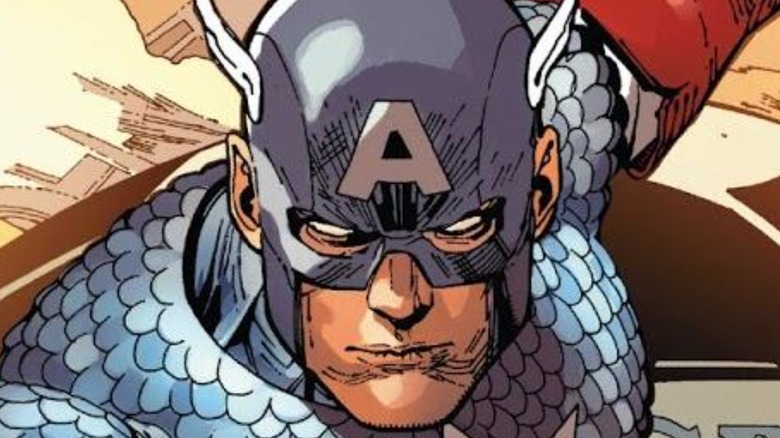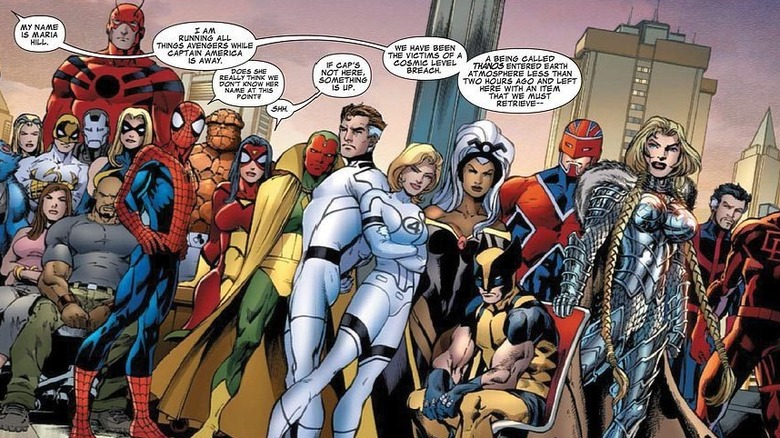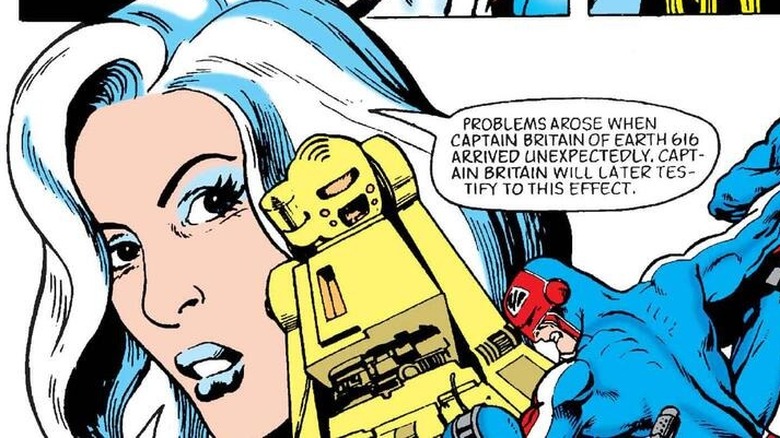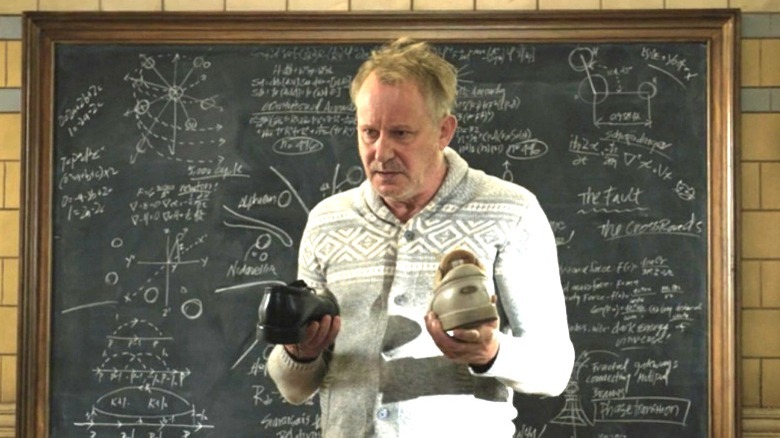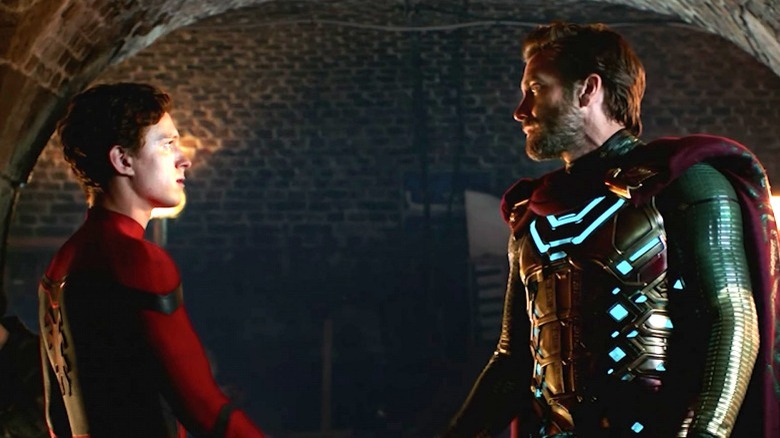Marvel's Earth-616 Explained
As we move further and further into Phase 4 of the Marvel Cinematic Universe, it's becoming abundantly clear that the multiverse is going to be an essential part of the franchise moving forward. The multiverse itself has already been a central focus of several major MCU projects, including the Disney+ series "Loki," which features multiple versions of the titular character from a slew of different realities, and "Spider-Man: No Way Home," which brings together three versions of Peter Parker from different universes (played by Tom Holland, Tobey Maguire, and Andrew Garfield).
Perhaps the biggest dive into the multiverse thus far comes in the Disney+ series "What If... ?", which gives fans a more concrete explanation of exactly what the Marvel multiverse looks like and the infinite possibilities that one can uncover by traveling across different realities. All told, it's clear that the multiverse will most likely be a major focus of the franchise's overarching story moving forward — which means there's a strong possibility that Earth-616 could make an appearance in the next phase of the MCU.
Longtime comic book fans will know just how important Earth-616 is within Marvel's multiverse and exactly what the appearance of this world within the MCU might mean for future films and comic books. But what exactly is Earth-616, and what is its relationship to the universe of the MCU?
Earth-616 is the main continuity of Marvel Comics
Earth-616 is the version of Earth in which the main continuity of Marvel Comics occurs, and the name is frequently used as a catch-all term to refer to the main Marvel Comics universe as a whole (via Marvel Database). This reality has gone by a multitude of different names throughout the years, including "Earth-One," "Prime Earth," "The Marvel Universe," "The Positive Zone," and "The Sacred Timeline" — the latter of which should sound awfully familiar to fans of "Loki."
The continuity of Earth-616 incorporates all the characteristics of our own reality (featuring all the same countries in our world and having gone through the same major historical events) while also possessing several features that are unique to their world alone. These include fictional countries like Wakanda, fictional organizations like S.H.I.E.L.D., and (most prominently) the presence of superpowers and superhuman individuals.
Despite the fact that Earth-616 is the central focus of Marvel Comics, its name indicates that it's actually rather far down the list in terms of the countless other realities present within the multiverse — and perhaps that's the point. Despite the fact that Earth-616 is the "main" universe, it's not the only world that matters amongst the limitless possibilities of the multiverse, and comic book authors have not been shy about exploring the infinite number of universes that exist concurrently with the main continuity.
The term Earth-616 was first created in the 1980s
Though the first official appearance of Earth-616 is technically in "Motion Picture Funnies Weekly Vol. 1" #1 (which was retroactively named as the beginning of the main Marvel Comics continuity, due to the appearance of superhero Namor the Sub-Mariner), the name "Earth-616" first appeared in the story "Rough Justice," which was published in the Marvel UK comic "The Daredevils" #7. According to Marvel.com, the term was initially coined by writer David Thorpe, who is best known for his work on "Captain Britain," and who (hilariously) first created the term because he wanted to separate Captain Britain from the main Marvel Comics continuity.
"Because we wanted to do anything we liked, we set a goal that Captain Britain was going to come back in this alternate universe," Thorpe explained. "which was nothing to do with what was then the mainstream Marvel Universe, so that anything that we did wouldn't upset the continuity of the main Marvel Universe. So it's kind of ironic that this universe became the mainstream Marvel Universe, because that was the exact opposite of the intention at the time."
Thorpe went on to describe how the number 616 simply came from subtracting 50 from 666, attributing the decision to his and fellow writer Alan Moore's shared interest in the occult. Though Thorpe may have failed spectacularly at trying to separate "Captain Britain" from the main Marvel Universe, his invention of Earth-616 has allowed countless writers to explore an infinite amount of different universes.
How does the MCU relate to Earth-616?
As of right now, the relationship between the Marvel Cinematic Universe and Earth-616 is a bit convoluted. The first reference to Earth-616 within the MCU came in 2013's "Thor: The Dark World," wherein astrophysicist Erik Selvig (Stellan Skarsgård) writes "616 universe" on a blackboard while he's confined to a mental hospital. The next time we hear about Earth-616 is in "Spider-Man: Far From Home," when Mysterio (Jake Gyllenhaal) tells Peter Parker (Tom Holland) that he is from an alternate universe and that the universe Peter is from (a.k.a. the universe that the MCU takes place in) is "Earth, Dimension 616." However, we later learn that this is simply a lie that Mysterio invents to earn Peter's trust.
In fact, the actual designation for the MCU's world is "Earth-199999," according to "Official Handbook of the Marvel Universe A to Z, Vol. 5," a book published in 2008. But Nate Moore, the VP of production and development at Marvel Studios, complicated things even more by calling the MCU's reality the "MCU-616 Universe" back in 2021. During an interview with the podcast "The Ringer-Verse," Moore discussed the future of Black Panther in the MCU following the tragic passing of Chadwick Boseman. Moore stated "You will not see T'Challa in the MCU-616 Universe," seemingly implying that the MCU's universe is actually Earth-616, or perhaps a separate version of Earth-616.
It's possible that Moore simply misspoke, especially considering just how different the MCU's version of Earth is from Earth-616, but the connection between the two realities remains unclear to this day. Perhaps if Earth-616 makes an appearance in some upcoming Marvel projects, we'll finally get some clarity as to where the MCU fits in within the multiverse.
Similarities and differences between Earth-616 and Earth-199999
There are plenty of similarities between the MCU's universe and Earth-616, especially when it comes to some of the major events that take place. This includes the "Infinity War" event and the "Civil War" event, both of which feature prominently within Marvel Comics and the MCU. More of what fans see within the MCU is adapted directly from the comics, and specifically from the Earth-616 continuity — though there are also some major differences between these two realities.
Perhaps the most notable difference between the two realities is the MCU's exclusion of certain superhero teams. The MCU has focused almost exclusively on the Avengers thus far and has yet to adapt the stories of other essential superhero teams like the X-Men or the Fantastic Four into their main continuity, both of whom are essential components of some of the biggest events in Marvel Comics. Also different is the status of some characters. For example, some characters who are alive in the comics (such as Iron Man) are gone forever from the world of the MCU.
If Earth-616 makes an appearance in any of the upcoming MCU projects, one has to hope that the crossover will finally allow for the introduction of characters, teams, and events that we have yet to see on screen.
A few of the higher-ups at Marvel absolutely hate the name
Earth-616 has become an iconic and essential aspect of Marvel's continuity ever since the term was first introduced back in 1983 — though unfortunately, the name isn't incredibly popular with some of Marvel's most prominent editors. Tom Brevoort, the executive editor of Marvel Comics, has gone on record to assert his disdain for the term. "I can tell you for sure that those of us actually working on the books virtually never use the term — and I kind of wince inside whenever I hear somebody use it," Brevoort explained. "It just sounds stupid to my ear, and so counter to the kind of mindset we try to foster in regard to the stories we create and the thinking we try to employ" (via Bleeding Cool).
This sentiment was echoed by Joe Quesada, the former editor-in-chief of Marvel Comics and current executive vice president and creative director for Marvel Entertainment. "I never use it," Quesada said during a Q&A for Newsarama.com. "I hate the term pure and simple and agree with Tom's assessment of it." Quesada and Brevoort's utter disdain for "Earth-616" doesn't exactly bode well for any sort of upcoming MCU and Marvel Comics crossover, especially since they both hold incredibly high positions within the company. Despite their distaste, there's no doubt that Earth-616 remains the central focus of Marvel's multiverse, and we have to imagine that Earth-616 will be referenced in some capacity as the MCU continues to dive deeper and deeper into the possibilities of the multiverse.
